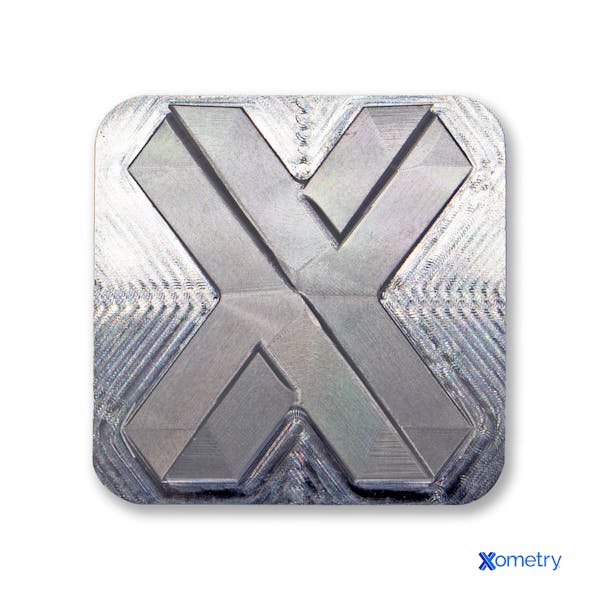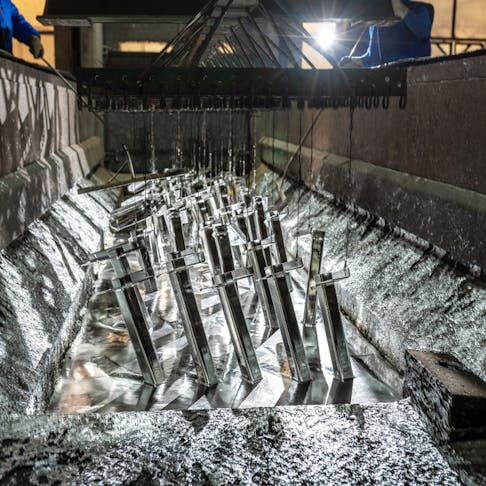Galvanized steel and aluminum are both manufacturing materials loved and used by Xometry customers, but they have very different properties that manufacturers should be aware of before choosing between the two. Let’s take a look at these two popular metals, their uses, pros and cons, and how Xometry can help you when it comes to using them for your business.
What is Galvanized Steel?
Galvanized steel refers to steel that has been hot-dip coated, electroplated, or mechanically plated—among other methods—with zinc, which protects it against corrosion. This process is called galvanization. Treating the steel in this way provides it with an ionic barrier that will sacrifice itself and prevent the steel from rusting, and that’s why galvanized steel has a long environmental lifespan. Here’s what galvanized steel looks like:

Due to its durability and corrosion resistance, galvanized steel is used in an impressive number of sectors and applications. Some of these include outdoor equipment (canopies, handrails, street furniture), adding corrosion resistance to parts (nuts, bolts, washers), being used in phone networks and power equipment boxes, and making pipes, and agricultural equipment (gates, barn components, livestock handling equipment).
Pros and Cons
Like with any type of metal, there are pros and cons to think about before using galvanized steel. Here’s the breakdown:
| Advantages | Disadvantages |
|---|---|
Advantages It has a low initial cost and excellent value for money because it can last a long time | Disadvantages While it’s protected against rust, it’s not fully immune to corrosion. Some aggressive environments, poor design, or minor mechanical damage could cause some corrosive decay |
Advantages Steel can hold its own against environmental factors or mechanical damage during handling, storage, transport, and erection, especially with the added zinc coating | Disadvantages It can be more expensive than other options like paints or powder coating |
Advantages You can make complex parts and structures with it because it’s malleable, ductile, and weldable, and environmentally stable, thanks to the zinc coating which is the most effective corrosion inhibitor available | Disadvantages It’s a bit of a diva when it comes to maintenance; if you want it to last a long time, it will need regular tending to |
Advantages - | Disadvantages It’s not exactly what you would call a lightweight metal |
Pros and Cons of Galvanized Steel
What is Aluminum?
Aluminum is another type of metal that’s found in abundance in the earth’s crust (meaning it’s pretty easy to get hold of), though it’s found in the state of metal salts like bauxite, which is a rock deposit that’s rich in aluminum oxide. Aluminum is lightweight when it’s made into its final metallic form. Here’s an example of what it looks like:

Aluminum is very versatile, and so is found pretty much everywhere—from cars, trucks, airplanes, ships, PC bodies, cans, and high-voltage conductors to body panels, wheels (alloyed with magnesium), frames, windows, doors, and roofs, to name a few. Xometry customers use this metal thanks to its many perks, including low density, high strength-to-weight ratio, corrosion resistance, and thermal conductivity.
Pros and Cons
In the following table, we compare aluminum’s advantages to its disadvantages:
| Advantages | Disadvantages |
|---|---|
Advantages It has a low density and high strength-to-weight ratio, so it’s perfect for situations that require less weight but good performance, like transportation | Disadvantages It’s more expensive than steel (its main alternative) because it requires a lot of energy to produce |
Advantages It naturally resists corrosion by forming an oxide layer on its surface when exposed to air | Disadvantages Its thermal conductivity could be a disadvantage in situations where you don’t want temperature distortion and unnecessary thermal transfer |
Advantages It’s a very good heat and electricity conductor (around 60% of the electrical conductivity and 50% of the thermal conductivity of copper, at a fraction of the raw material cost) | Disadvantages It can become brittle and lose some of its structural strength and durability when exposed to sudden temperature changes or extremely high temperatures |
Advantages It’s ductile, malleable, and somewhat weldable | Disadvantages Compared to other metals, it has a low melting point which can become an issue in high-temperature applications |
Advantages It’s highly recyclable, and it actually requires less energy to recycle than it does to make | Disadvantages Although it’s more corrosion-resistant than many other metals, it can still corrode in some environments |
Pros and Cons of Aluminum
Galvanized Steel vs. Aluminum
Choosing between these two metals will first require a comprehensive comparison of their properties (don’t worry; we’ve got one below for you). What it will come down to in the end are your exact needs and budget. Sometimes these materials can be used for the same thing, such as walkways, stairs, and fan blades, but most times you’ll find that one will be better than the other at making a particular item. For example, galvanized steel is stronger and more durabile, but it certainly can’t beat aluminum when it comes to light weight and strength-to-weight ratio. Further comparisons can be found in the table below:
| Properties | Galvanized Steel | Aluminum |
|---|---|---|
Properties Malleability | Galvanized Steel Moderately malleable; it can be shaped but is not as flexible as aluminum. It can be formed more easily when it’s heated. | Aluminum Highly malleable; it’s easy to bend, shape, and form into complex designs without losing its structural integrity |
Properties Price | Galvanized Steel Approximately $0.50 to $1.50 per pound | Aluminum Typically $1.50 to $3.00 (sometimes more) per pound |
Properties Durability | Galvanized Steel It’s very durable, especially in outdoor and somewhat corrosive environments, but it could rust if the zinc coating gets damaged | Aluminum It’s naturally corrosion-resistant and lightweight, helping it last a long time |
Properties Rust-Resistance | Galvanized Steel It’s very rust-resistant because of the zinc coating | Aluminum It doesn’t rust but it could become vulnerable in acidic, alkaline, or salt-heavy areas |
Galvanized Steel vs. Aluminum Properties
How Xometry Can Help
Xometry provides a wide range of manufacturing capabilities, including 3D printing, laser cutting, CNC machining, and much more. Both galvanized steel and aluminum are popular among Xometry customers. Want to learn more about either of these metals or request a free no-obligation quote? Reach out to a Xometry representative today.
Disclaimer
The content appearing on this webpage is for informational purposes only. Xometry makes no representation or warranty of any kind, be it expressed or implied, as to the accuracy, completeness, or validity of the information. Any performance parameters, geometric tolerances, specific design features, quality and types of materials, or processes should not be inferred to represent what will be delivered by third-party suppliers or manufacturers through Xometry’s network. Buyers seeking quotes for parts are responsible for defining the specific requirements for those parts. Please refer to our terms and conditions for more information.


